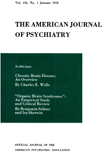A METHOD FOR STUDYING THE ORGANIZATION OF TIME EXPERIENCE
Abstract
A method for studying the process of self-evaluation and organization of time experience is described. It utilizes an experimental situation in which the subject is not aware of the experimenter's interest in time perception, in which external cues are minimal and "experiential" cues are confusing. Intervals in the dark are judged as longer than intervals during which the subject is in the presence of an "auto-kinetic" light. There are significant individual differences in the pattern of temporal organization. Ways in which subjects approach the experimental task are described qualitatively. Theoretical and practical implications, including implications for the study of psychopathological phenomena, and possible extensions and variations of the method are discussed.
Access content
To read the fulltext, please use one of the options below to sign in or purchase access.- Personal login
- Institutional Login
- Sign in via OpenAthens
- Register for access
-
Please login/register if you wish to pair your device and check access availability.
Not a subscriber?
PsychiatryOnline subscription options offer access to the DSM-5 library, books, journals, CME, and patient resources. This all-in-one virtual library provides psychiatrists and mental health professionals with key resources for diagnosis, treatment, research, and professional development.
Need more help? PsychiatryOnline Customer Service may be reached by emailing [email protected] or by calling 800-368-5777 (in the U.S.) or 703-907-7322 (outside the U.S.).



